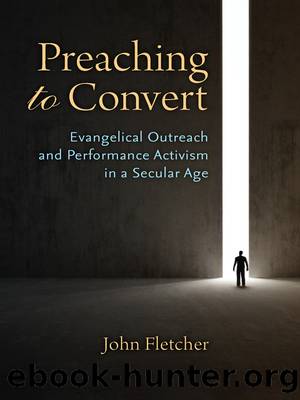Preaching to Convert by Fletcher John;

Author:Fletcher, John; [Fletcher, John]
Language: eng
Format: epub
Publisher: University of Michigan Press
Preaching to the Converted
Like the Museum's initial displays, nothing in this final section of the tour would likely convince someone not already a believer operating from a strong young-earth worldview. Earlier, I described the Creation Museum as preaching to the converted, drawing again on Tim Miller and David Román's rejuvenation of this phrase. Responding to the âpreaching to the convertedâ criticism often leveled at queer artists (i.e., that they perform exclusively for LGBT audiences), Miller and Román point out that the charge dismissively and inaccurately homogenizes an audience of âthe convertedâ into passive receptacles for whatever propaganda the preacher/performer wishes to feed them. Using Miller's own interactive performance practice as an example, they argue that all performance, and especially community-based performance, is more complicated than the one-way model of speaker/hearer suggests. In cases where a community of spectators attends a performance that purports to be by, for, and about people and viewpoints of their own community, audience/performer interactions take on a heightened charge, with audience members constantly checking a performance's presentation of the community's identity and beliefs with their own understandings of those beliefs.52
Miller and Román's reminder about the heterogeneity even of âconvertedâ audiences takes on special relevance in relation to the Museum's engagement with evangelical culture. I should first reiterate the diversity of fundamentalist, evangelical, and creationist communities that patronize the Museum.53 AiG presents but one sermon among many others, one specific alignment of creationism, evangelism, and Bible-believing among a smorgasbord of other theologies. As evangelical culture typically flourishes outside of the regulatory structure of formal denominations, and thus beyond the purview of unifying (and border-defining) creeds, evangelicals are used to encountering and evaluating for themselves multiple, overlapping, and conflicting messages. Such instability, however, only underlines the need for and utility of preaching to the converted. Miller and Román argue that conversion isn't a one-time event. âIf âthe convertedâ exist,â they write, âthen âthe convertedâ needs to be understood as a dynamic assembly that both individually and communally enters the space of performance to sustain that conversion.â54 Miller and Román offer âpreaching to the convertedâ as a productive, even necessary activist tactic, a practice of reminding members of the activist community (in this case, Bible-believing evangelicals) of the content and stakes of their struggle, re-energizing them with new strategies and renewed passion.
Evangelicals hardly need a reminder about the power of preaching to the converted, of course: as their own saying attests, âYou preach to the choir to get them to sing.â Evangelicals affirm that every human has an innate sense of God and God's law; this existential given in fact forms the basis of communicative bridges across presuppositional divides in apologetics. Worldview analysts, however, acknowledge that a comprehensive, fully articulated worldview doesn't come into being on its own, nor can Christians maintain their worldview's integrity without frequent renewal. In this sense, seeing the Creation Museum as a kind of activist preaching to the converted reframes my reading of its motto: âPrepare to believe.â The focus, I find, is not on belief per se but on preparation.
Download
This site does not store any files on its server. We only index and link to content provided by other sites. Please contact the content providers to delete copyright contents if any and email us, we'll remove relevant links or contents immediately.
Eats, Shoots & Leaves by Lynne Truss(1128)
Nickel and Dimed by Barbara Ehrenreich(932)
Midnight's children by Salman Rushdie(788)
Bring Up the Bodies by Hilary Mantel(676)
Black Coffee (Poirot) by Agatha Christie(651)
The Lovely Bones by Sebold Alice(641)
Buried Child by Sam Shepard(625)
The 500 by Matthew Quirk(621)
The Seagull by Anton Chekhov(607)
An Ideal Husband by Oscar Wilde(587)
The Imaginary Invalid by Molière(583)
Steven Berkoff by Steven Berkoff(562)
Finding Roger by Rick Elice(507)
Tobacco Road by Erskine Caldwell(495)
Profiles by Tynan Kenneth; Tynan Kathleen;(495)
The Comedy Bible by Judy Carter(494)
Shakespeare by Paul Edmondson(481)
The Tragedy of Mister Morn by Vladimir Nabokov & Thomas Karshan & Anastasia Tolstoy(469)
Mrs. Warren's Profession by George Bernard Shaw(465)
